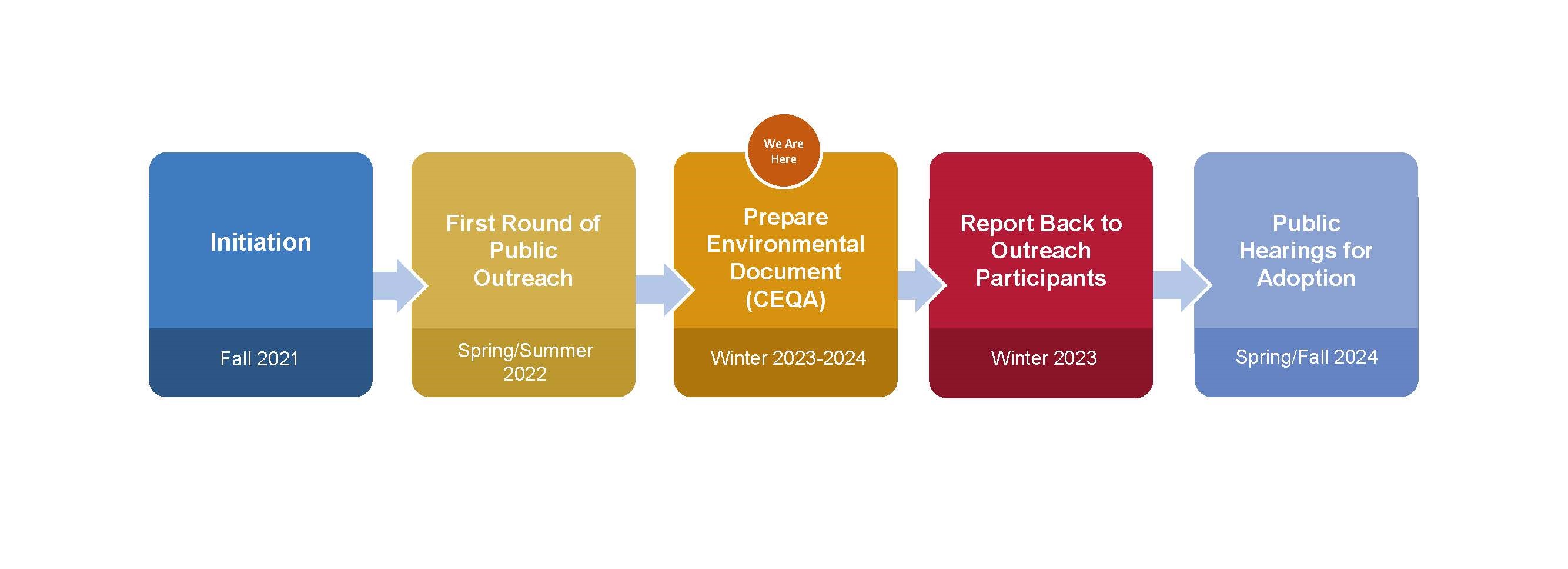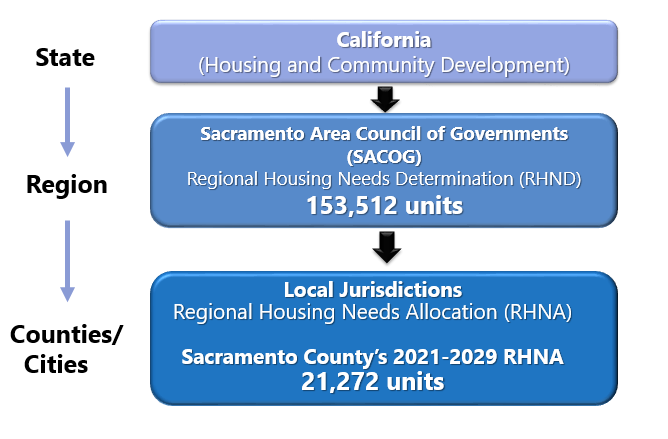Sacramento County currently has a shortfall of available vacant sites that would accommodate its lower-income Regional Housing Needs Allocation (RHNA). Under state law, the County is required to ensure that enough suitably zoned land is available to accommodate the RHNA at the required density of 30 dwelling units per acre. To address this deficiency, the Board of Supervisors initiated a rezone and Zoning Code amendment on October 20, 2021 to take the following actions:
Rezone at least 165 acres to multi-family zoning classifications.
Amend the Zoning Code to implement Housing Element programs A2 and B7 and modify the density range or maximum density for properties zoned Residential 20 (RD-20) or greater; and
Amend Special Planning Areas (SPAs), as necessary, to modify the density range or maximum density for RD-20 and greater zoned properties.
Timeline
Statutory Deadline – Mid 2024
The countywide rezoning process was initiated in Fall 2021 and will culminate in its adoption by the Board of Supervisors in 2024.
Staff is currently preparing the necessary environmental document for the candidate rezone sites. A Notice of Preparation (NOP) for the Project was issued on June 12, 2023. Given Project refinements, specifically the adjustment in acreages proposed for rezone, a revised NOP was issued on December 22, 2023 (available below). Comments on the NOP may be submitted through January 22, 2024; please refer to the NOP for methods to submit comments.

Public Outreach:
- Scoping Meeting
- Workshops (TBA)
- Hearings (TBA)
Project Documents:
A Draft SEIR has been prepared by the County of Sacramento pursuant to the California Environmental Quality Act (CEQA) Guidelines. The public review period for the Draft SEIR begins April 5, 2024 and ends on May 20, 2024. Comments on the Draft SEIR should be directed to:
Jessie Shen, Senior Planner
Department of Community Development
Planning and Environmental Review Division
827 7th Street, Room 225, Sacramento, CA 95814
Future Rezoning Efforts
The County's foremost priority is fulfilling its RHNA obligation as mandated by State law by the statutory deadline. The County remains committed to rezoning additional properties and intends to bring forth a second package of rezone sites specifically in the Vineyard community. A defined timeline for the second package will be provided when available. Please revisit this webpage for future updates.
FAQs
Nothing. Neither the property owner nor the County are required to build the units estimated to be provided on the Land Inventory. If you sell the property or choose to develop it as multifamily, you or the future owner/developer will be required within the density range identified by its new zoning classification.
The State has outlined criteria for vacant sites to be designated as suitable for housing development affordable to lower-income levels:
- Sites must be at least 0.8 acres, but less than 10 acres.
Have existing access to infrastructure (e.g. water, sewer, dry utilities)
Be in close proximity to services (e.g transit opportunities, parks, commercial centers)
County staff also prioritized rezoning sites that already allowed multifamily development; many of the sites on the rezone list already allow a housing density of 20 units per acre, but must allow at least 30 units per acre to satisfy the lower-income RHNA.
The County has also committed to rezone sites equivalent to 30% of the remaining lower-income RHNA along commercial corridors in moderate, high, and highest-resource areas to affirmatively further fair housing choice. This includes portions of Fair Oaks, Carmichael, Orangevale, Cordova, and Antelope. More information on the requirement to affirmatively further fair housing can be found on the State of California Housing and Community Development Department (HCD) website.
The RHNA is a minimum projection of additional housing units needed to accommodate projected growth of all income levels by the end of the Housing Element’s planning period.
Every eight years, HCD provides Sacramento Area Council of Governments (SACOG) with an amount of dwelling units the region must plan for. SACOG is then responsible for allocating these units to each city and county within its region. Each jurisdiction then adopts a Housing Element that demonstrates how they can accommodate their RHNA units in their zoning.

More information on SACOG’s process for RHNA calculations can be found on their website.
Sacramento County’s total RHNA for 2021-2029 at
all income levels is shown below. Please note that the County is proposing to
rezone properties to accommodate lower and moderate income housing need.
Income Category
| Number of Units
| Percentage
|
|---|
Lower-Income
| 7,158
| 33.6%
|
|---|
Moderate-Income
| 4,186
| 19.7% |
|---|
Above Moderate-Income
| 9,928
| 46.7%
|
|---|
Total
| 21,272
| 100% |
|---|
Lower income is inclusive of the low, very low and extremely-low income categories. These following income ranges are based on a percentage of Sacramento County’s average median income:
Extremely Low-Income
| $0 - $25,900
| N/A. Typically residents on fixed incomes (e.g., social security, disability)
|
Very Low-Income
| $25,901 - $43,150
| Food Preparation and Serving; Personal Care and Services; Farming, Fishing, and Forestry
|
Low-Income
| $43,151 - $69,050
| Sales and Retail; Healthcare Support; Office and Administrative Support
|
Moderate-Income
| $69,051 - $103,550
| Education, Training, and Library; Community and Social Services; Installation, Maintenance and Repair; County Planners |
These are based on the “opportunity index” maps prepared by HCD and the California Tax Credit Allocation Committee (TCAC). The maps are intended to display the areas that, according to research, offer low-income children and adults the best chance at economic advancement, high educational attainment, and good physical and mental health.
The primary function of TCAC is to oversee the Low-Income Housing Tax Credit (LIHTC) program, which provides funding to developers of affordable rental housing. The opportunity maps play a critical role in shaping the future distribution of affordable housing in areas with the highest opportunity.
A map showing the opportunity index of the unincorporated areas of the County can be found on the CTAC/HCD Opportunity Area Maps webpage.
The County is required to complete the rezone program by May 2024. If the County fails to fulfill its rezone obligation, the California Department of Housing and Community Development (HCD) will likely de-certify the Housing Element and potentially pursue legal action against the County. Not having a certified Housing Element will also cause the County to become ineligible for state funding critical for new housing construction and unable to maintain existing affordable housing.
